Mayoiga has to be one of the most misunderstood shows in recent years.
On a surface, the premise alone has a lot of potential. The idea behind putting 30 people, each of them has very different set of personalities, together in a bus to a mysterious lost village, in order to start over new life is an intriguing concept, because there could be lots of angles to explore, even within its mystery/horror fare. The show could use the setting to explore the internal conflicts between the cast, or the nature of those monsters that drive anyone insane or even dig deep to the mystery behind Mayoiga, or the show can go full cannibalism that was suggested many times in the first episode.
Instead Mayoiga goes off track very early and never looks back and the overall execution certainly stands out, in a very-bad-it’s-good way
Billed as a mystery show, Mayoiga contains many elements that feel like a recipe for disaster: over the top characters, awkward pacing, long and meaningless conversations. In the first 10 minutes of the show for example, literally EVERYONE in the cast got introduced (and that 20 plus characters to remember). The characters have a distinct and overall solid character designs; but most of them are way too over the top to feel like real people. Mitsumune, our main character, for instance, feel really bland and his only traits are unsure about himself and his affection towards Masaki. The conversation drags on, don’t really advance the plot or flesh out the characters. Worst of all, the pacing sucks, sometimes it drags for too long before moves too quickly, for example in the first half of the show, there are few episodes where nothing important happens except the cast arguing. The cast themselves uses their time wisely to talk about how to call rock, paper, scissor the most correct way, arguing over the name of one of the cast who just vanished, or lying asleep in the end without the care of anything else. The cliffhangers, were presented in almost the end of every episode, just so that the stake returns back to normal in a very next moment.
Thematically, Mayoiga actually has its meaning underlying under the surface. The monsters are revealed to be Nanaki, which are part of each individual’s past psychological trauma, come to life. They are a symbol of all those ugly things that the cast left behind to start over their new life. They are not, as the series progresses, intend to harm the cast, but are a part inside each character, and the show made a point (as in your face as possible) that all of them need to face their own Nanaki (their traumatic past) in order to become a better person. The Nanaki monsters, represented in 3D animation, are both out of place and uneasiness at the same time, which actually fits to the theme very well. But I have to say, reading this underlying message is a bit too much, as the series itself never attempt to dig deeper into its theme.
Which brings me to the next point, many of the above elements actually WORKED in favors of the show. One thing that Mayoiga truly excels, the one thing that Mayoiga will likely be remembered for years to come, is its ridiculousness. All the ridicuolous, awkward bits are intentional, majority of them are so well-aware that it becomes hilarious. Many of the Nanaki monsters, for instance, are just plain silly in concept, such as a big silicon boob monster (yeah! You read it right!), or a girl seeing a giant Mitsumune because he happens to look like her ex-boyfriend, so instead of seeing her ex she would see Mitsumune who she just met for 2 days. See the absurd sense of logic here? Indeed, most of the cast embrace that ridiculous sense of logic wholeheartedly that it’s actually refreshing to see them keep betraying our expectation. Lovepon would be nothing if not for her “execution” speech, and after a while it’s just feel so welcome to see her running for her life from the monster, still remain in character “We going to be executed!!”. The Driver and his bus also keep appear/ vanish without any explaination is also a good running gag. Other characters, like Mitsumune, Hayato, Koharun, Nanko, actually the whole cast also embrace their one-note traits to a bitter end, put it up to the max that they become so gimmick and fun to watch. The conversations, as I mentioned above, drag on and on; but there is a lot to enjoy there, mainly for their unique train of thoughts and the ridiculous topics they could come up to.
Like I mentioned in my review posts, Mayoiga is a masterclass of using anti-climax not only to twist our expectation out of the usual conventions, but also to reduce any tension whatsoever. Take the revealing about the nature of Nanaki for examples, in a sequence where 4 members of our group witness their own Nanaki, they seem defeated, had nowhere to run but somehow, all of them managed to escape from it, without any injury. In other scene we witness the group decided to tied Masaki up and attempted to stab her, just so that she got ambushed by the bus driver, who drove her away just to beg her to allow him to meet his daughter again. The extensive use of anti-climax might seem uneven, absurd and even laughable at first, but actually these are all intentional so that the show can screw you out of any conventional sense.
But self-aware or not, Mayoiga can’t hide a fact that, in a nutshell, this show is an incoherent mess. In fact, inconsistency is the only consistent trait the show has. Mayoiga always feels like a product of too many minds, too many ideas that crammed all together, that contributes to too many half-baked ideas, and the pacing is all over the place. This seems understandable though, as in the process of making Mayoiga, the director Tsutomu Mizushima (Girls un Panzer, Shirobako, Prison School) encouraged the team to come up with ideas, and Mari Okada responsible for putting everything together. On that note I have to say the ending is surprisingly conclusive. Yes we would never know what happen to the people before the cast arrived, or how the majority of the cast meet their Nanaki (they JUMPED straight from those guys sleeping to they being back to the bus), but all the main questions are addressed and I actually feel kind of satisfied with the ending. This is a show with lots of obvious flaws, but it is also a show that unlike most of our usual anime fare. I have a great time with Mayoiga and ’m happy that I got the chance to cover it.
~SuperMario~

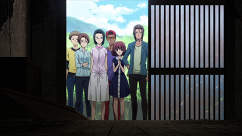
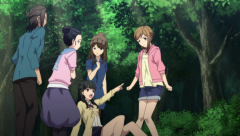
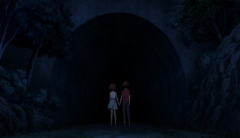

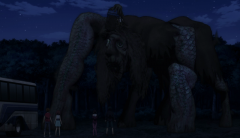
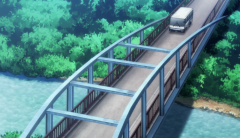
I was so furious after the last episode. I was really excited after the first few episodes, despite laughing through them literally using an episode to introduce the characters, as you said.
Then it just dicked around, introduced a few fake-out villains, then ended in a really cop-out unsatisfying sort of way. I haven’t been so infuriated by the lack of a satisfying wrap-up since the second season of Tokyo Ghoul.
Tell me more about which parts that you feel unsatisfied. This is for me one of the best possible way the show could’ve ended, wrapping the main things up and still remains as ridiculous as hell.
Instead of ranting about the waste of time and black matter this anime is. I’ll ask, is this an example of anti-horror, since I didn’t find it cheesy or charming enough to be a horror-comedy.
It’s a shame I wanted an Another-type of anime with this one.
You say it’s a waste of time, I say I had a great time watching it.
I never understand the concept of anti-something genre (like anti-western, anti-musical) but from what I know: no, this is not an anti-horror show. I’ll say it’s more into anti-mystery territory but didn’t quite get there yet.
Is this a well EXECUTED story?
In terms of our Lovepon: yes, definitely.
In terms of everything else: No, god. No.